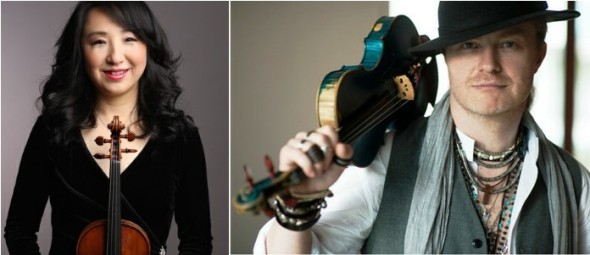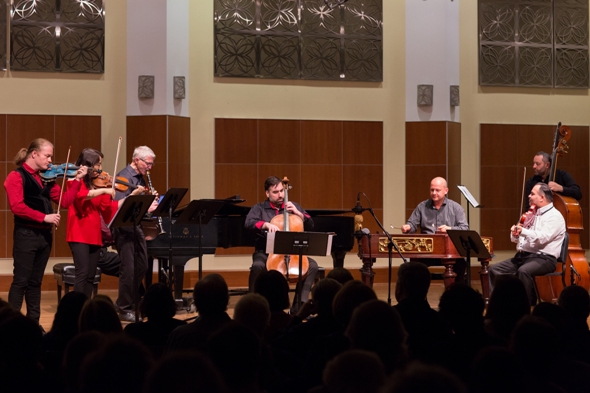Civitas, Gipsy Way musicians pursue cultural connections and leave digital footprints, too
Review: “Alla Zingarese,” an international collaboration of Prague’s Gipsy Way Ensemble and Chicago’s Civitas, makes its mark.
By Nancy Malitz
Shanghai-born violinist Yuan-Qing Yu is a tenacious advocate for contemporary music and a member of the classical music elite as assistant concertmaster of the Chicago Symphony Orchestra.
Pavel Šporcl, born near Prague, is a celebrated violin virtuoso with a gypsy crossover streak and a bodaciously blue violin.
Yu and Šporcl met more than 20 years ago as fellow students in the class of violin pedagogue Eduard Schmieder, whose prestigious studio was then at Southern Methodist University in Dallas. While in school the two performed frequently together and learned about each other’s traditions — in Šporcl’s case the improvisatory, so-called gypsy music of the Romani people, which he has helped to de-stigmatize.
After university, Yu and Šporcl went their separate ways, although their shared influences are apparent. Šporcl’s Gipsy Way Ensemble has gone platinum but so have his formidable classical recordings. Yu remains fascinated by gypsy music and at one time sought tips from a local jazz violinist in freeing herself from the written note. The Civitas Ensemble – which Yu co-founded with Chicago colleagues – continues to explore the wider musical world.
Two years ago Šporcl and Yu hatched the ambitious idea of bringing Civitas and Gipsy Way together in a cultural combustion of classical, jazz and gypsy musical elements. They dubbed their project “Alla Zingarese” and received funding through the MacArthur Foundation to film and record the project, commission new works, and perform in both Prague and Chicago.
The exhilarating concert that I heard May 21 at the Merit School of Music was both a trip through history – with gypsy-inspired works by Enescu, Liszt, Sarasate and Brahms – and a venture into new musical territory with surprises aplenty. Seductive airs and folk dances with syncopated come-ons and relentlessly accelerating speeds were the essential ingredients. After the concert, the players laid down tracks for a recording through Cedille Records and trekked over to WFMT-FM radio, where they talked about the project and performed most of the music again. (Access the podcast here.)
There is a magnetic push-pull generated by these two quite different foursomes: Civitas has a violin, clarinet, cello and piano; Gipsy Way incorporates a violin, viola, string bass and cimbalom. Much of what makes gypsy violin sound like a gypsy violin is a matter of technique and turn of phrase, but the contribution of the cimbalom adds an unmistakable color. It’s similar to a small piano, except that the player uses leather beaters on the strings directly, instead of a keyboard. Long notes can swell and fluctuate in a way they cannot on the piano.
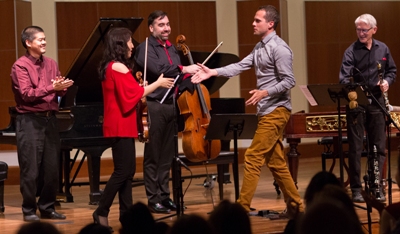 Since nobody writes music for the particular Gipsy Way-Civitas grouping of eight requires, new works and clever adaptations have been summoned. Šporcl and Chicago’s Cliff Colnot did some of the arranging; the talented young Czech composer, guitarist and arranger Lukáš Sommer, a friend of Šporcl, did the rest. Sommer also composed two entirely new works – one for the whole group, premiered in Prague, and the other, “Cigi-Civi,” for the Civitas quartet alone, premiered in Chicago..
Since nobody writes music for the particular Gipsy Way-Civitas grouping of eight requires, new works and clever adaptations have been summoned. Šporcl and Chicago’s Cliff Colnot did some of the arranging; the talented young Czech composer, guitarist and arranger Lukáš Sommer, a friend of Šporcl, did the rest. Sommer also composed two entirely new works – one for the whole group, premiered in Prague, and the other, “Cigi-Civi,” for the Civitas quartet alone, premiered in Chicago..
The concert began in a European comfort zone: Civitas members played an arrangement (by Colnot) of Enescu’s “Romanian Rhapsody” in A major, followed by Winston Choi’s solo piano tour through Liszt’s “Hungarian Rhapsody” No. 12. Both were first-rate performances of familiar works delivered in a mainstream style, which is to say, flavored by gypsy accents but still flowing with the elegance, restraint and rigor of musicians trained in the Western classical tradition.
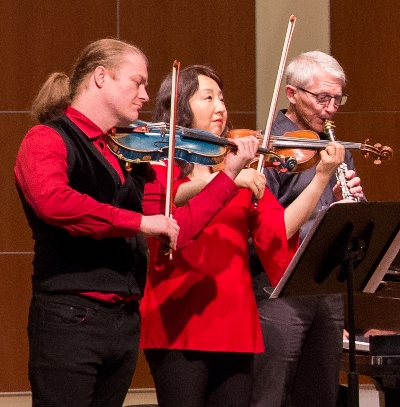 What turned the lights on for me was the change of emphasis when the eight players from these two different traditions lit into joint readings of gypsy-flavored classics I thought I knew – Sarasate’s “Zigeunerweisen” (Gypsy Airs), Hubay’s “Scenes from Csárdás” No. 5 and two selections by Brahms — “Hungarian Dance” No. 1 and the “Rondo alla Zingarese” from Brahms’ Piano Quartet in G minor.
What turned the lights on for me was the change of emphasis when the eight players from these two different traditions lit into joint readings of gypsy-flavored classics I thought I knew – Sarasate’s “Zigeunerweisen” (Gypsy Airs), Hubay’s “Scenes from Csárdás” No. 5 and two selections by Brahms — “Hungarian Dance” No. 1 and the “Rondo alla Zingarese” from Brahms’ Piano Quartet in G minor.
As an example, the work by Sarasate (who was a 19th-century composer and violin virtuoso in the Paganini tradition) is imbued with dazzling fiddle stunts that literally flew by and offered no technical difficulties whatsoever for either Yu or Šporcl. But that is not to say Yu and Šporcl played alike. There was delicious artistic tension generated by Yu’s powerful bow arm, juicy vibrato and bullet-like accuracy, and Šporcl’s laid-back swagger and indulgent fingerboard dalliances even at blistering speeds. Such semantic contrasts occurred repeatedly, among all the players, throughout the concert. Vive la différence.
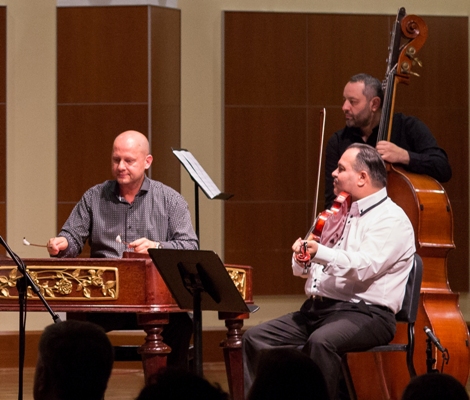 Discoveries and differences abounded: CSO clarinetist J.Lawrie Bloom gave his instrument the wail of Yiddish klezmer music; in fact, his playing seemed such a natural fit for the throaty folk tunes of the Romani tradition that it was confounding to learn, from Bloom himself, that the clarinet has no particular role in that tradition. Gipsy Way violist Zoltán Sándor rested the end of his fiddle sidewise on his chest; along with double bassist Ján Rigó, he functioned as the group’s rhythmic engine. CSO assistant principal cellist Kenneth Olsen, a member of Civitas, provided rhythmic underpinning, too, but he also freely traded with the violins, cimbalom and piano in sharing the melodic line.
Discoveries and differences abounded: CSO clarinetist J.Lawrie Bloom gave his instrument the wail of Yiddish klezmer music; in fact, his playing seemed such a natural fit for the throaty folk tunes of the Romani tradition that it was confounding to learn, from Bloom himself, that the clarinet has no particular role in that tradition. Gipsy Way violist Zoltán Sándor rested the end of his fiddle sidewise on his chest; along with double bassist Ján Rigó, he functioned as the group’s rhythmic engine. CSO assistant principal cellist Kenneth Olsen, a member of Civitas, provided rhythmic underpinning, too, but he also freely traded with the violins, cimbalom and piano in sharing the melodic line.
The brooding introductory chords of cimbalom player Tomáš Vontszemü had the familiar scene-setting effect of Western fanfares, but in the bounce of those mallets on the steel strings there was also an expressive wealth of flickering moods and colors that buttressed the melodic lines. A special guest at the Merit concert, cimbalom player Nicolae Feraru – not a member of either ensemble but a well-known virtuoso on the instrument whose career was for years Chicago-based – made a free-wheeling cameo appearance that put the cimbalom’s flamboyant expressive capabilities front and center.
Sommer’s lively, if brief,“Cigi-Civi,” the world premiere on the program, was for Civitas alone. It was marked by quintuple meter and Stravinsky-like syncopations framing a contemplative episode that was persuasively delivered by Olsen on cello, but it seemed to end almost before it began.
A more substantial evocation of the gypsy tradition came with Sommer’s other work, premiered in Prague last January and repeated here. Written for the entire group, “Cikanska Odyssea” (Gypsy Odyssey), began with a distinctive syncopated motto that slowly accelerated to dizzying speed. There were novel trade-offs, percussive hand slaps and even a scene-stealing cadenza for Šporcl, who slammed on the brakes to revisit Sommer’s captivating initial idea before a final rocketing spin.
Šporcl also adapted his own well-known composition “Gypsy Fire” for the eight players. It was the hit of the concert and reflected the showpiece style favored by Paganini and other legendary virtuosos. A grand introductory solo violin cadenza soon had everyone joyfully piling on – a riot of high-speed perpetual motion with stratospheric harmonics, trills and leaps, double stops, parallel octaves and catchy rhythms galore, giving everyone a turn in the spotlight. Šporcl’s 2015 album, spelled “Gipsy Fire,” which went platinum, includes the work for his own smaller forces. Cedille Records will release the new version.

